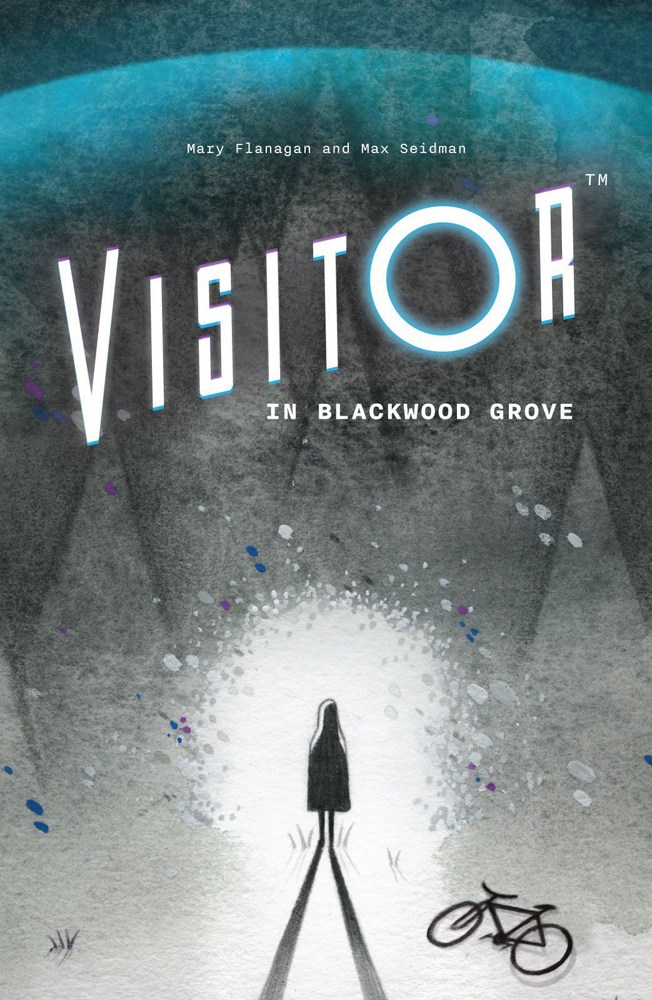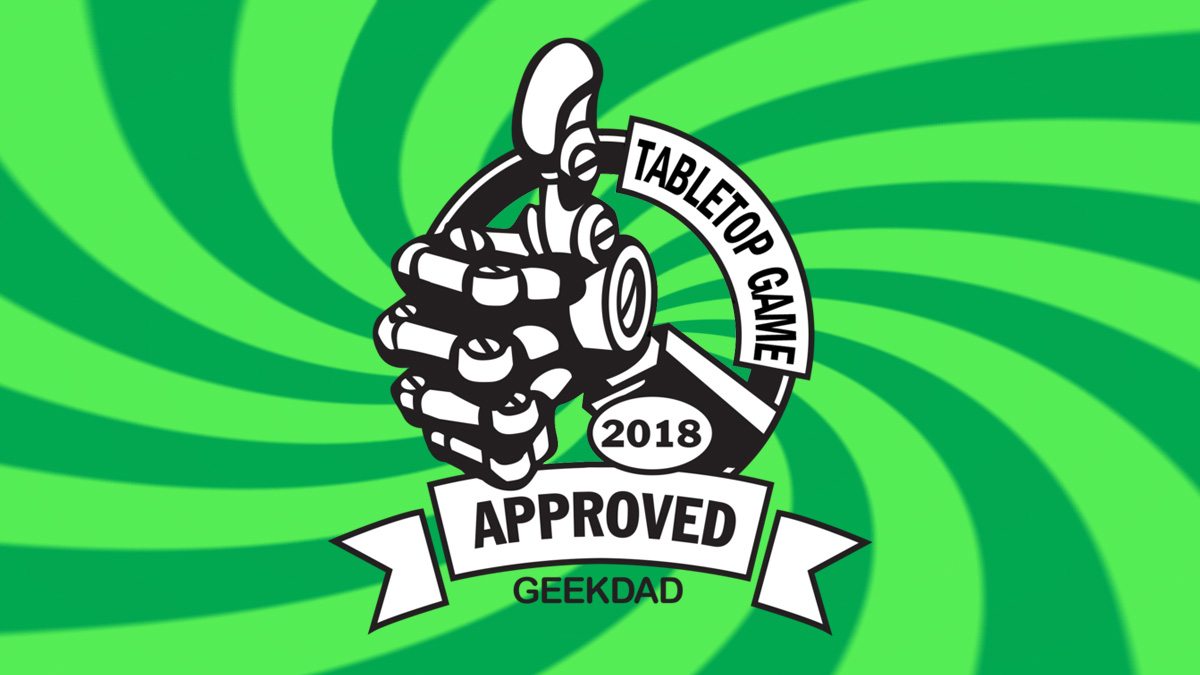Government agents have descended on Blackwood Grove, intent on recovering the crashed UFO—only to find a mysterious force field keeping them out. It’s only a matter of time before they break through. Can the kid build up enough trust with the visitor to help it escape?
What Is Visitor in Blackwood Grove?
Visitor in Blackwood Grove is a game of induction for 3 to 6 players, ages 8 and up, and takes about 5–15 minutes to play. It was funded last year on Kickstarter and was delivered to backers earlier this year. It retails for $20, and Resonym announced in July that it would be available exclusively at Target (in stores and online) starting today.
Visitor in Blackwood Grove is GeekDad Approved!

Visitor in Blackwood Grove Components
- Force Field board
- Visitor shield
- 142 Object cards
- Trust mat
- Meeple
- 4 Guess tokens
- 6 Role cards (Visitor, Kid, 4 Agents)
- Cloth bag
- 10 marker tokens
- 13 Pass Rule Example cards
- 14 card stands (Kickstarter edition only)
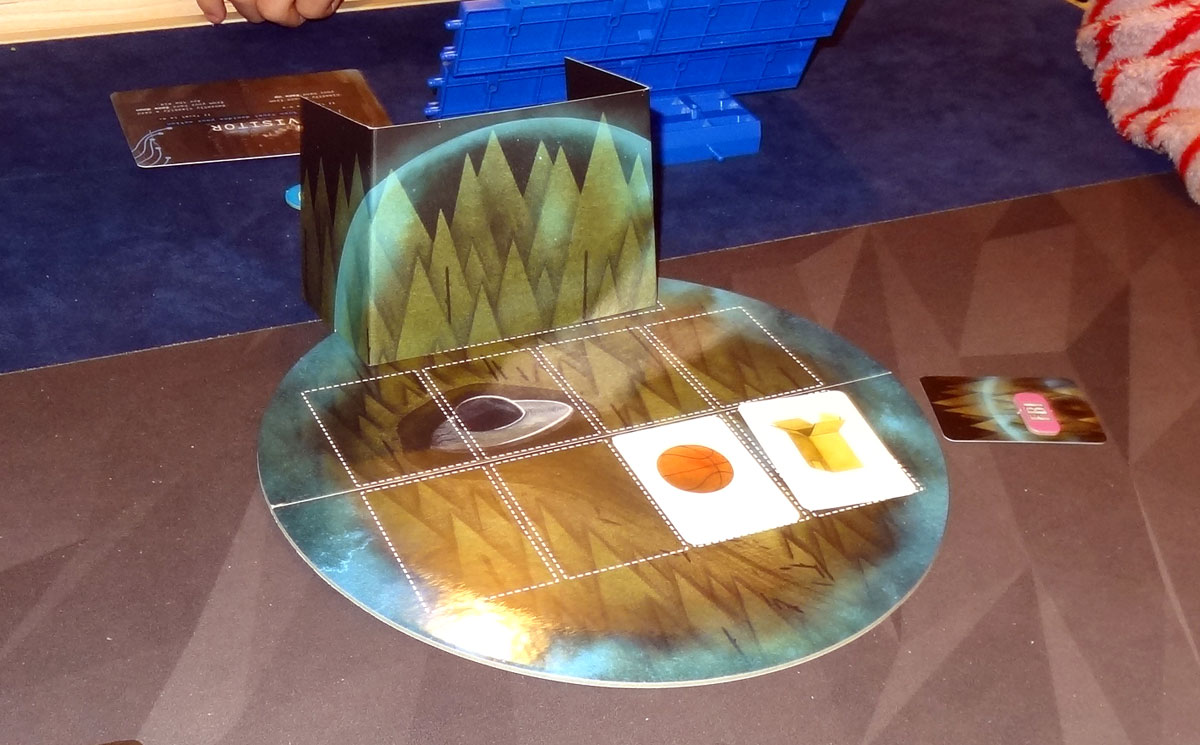
The force field board is a large cardboard circle, with spaces marked for 8 cards and the folding shield on one edge. It’s illustrated to look like a crashed UFO in a forest, with a blue glow around the edge that has UV gloss for a nice sheen. The visitor shield is a little folded cardstock: the notched edge is a nice touch, letting it sit off the edge of the board, and the illustration carries over onto the shield. My only complaint about the board is that it doesn’t really have room for all the face-down player cards that may be added to it during play—these will just be placed overlapping the edge of the board—but it does keep the overall size of the game pretty small.
The various player cards—agents, visitor, and kid—are oversized cards that have simple reminders about turn order for the characters, and the trust mat is a longer piece of cardstock that tracks the kid’s trust level with the visitor (and accompanying effects for each trust gained).
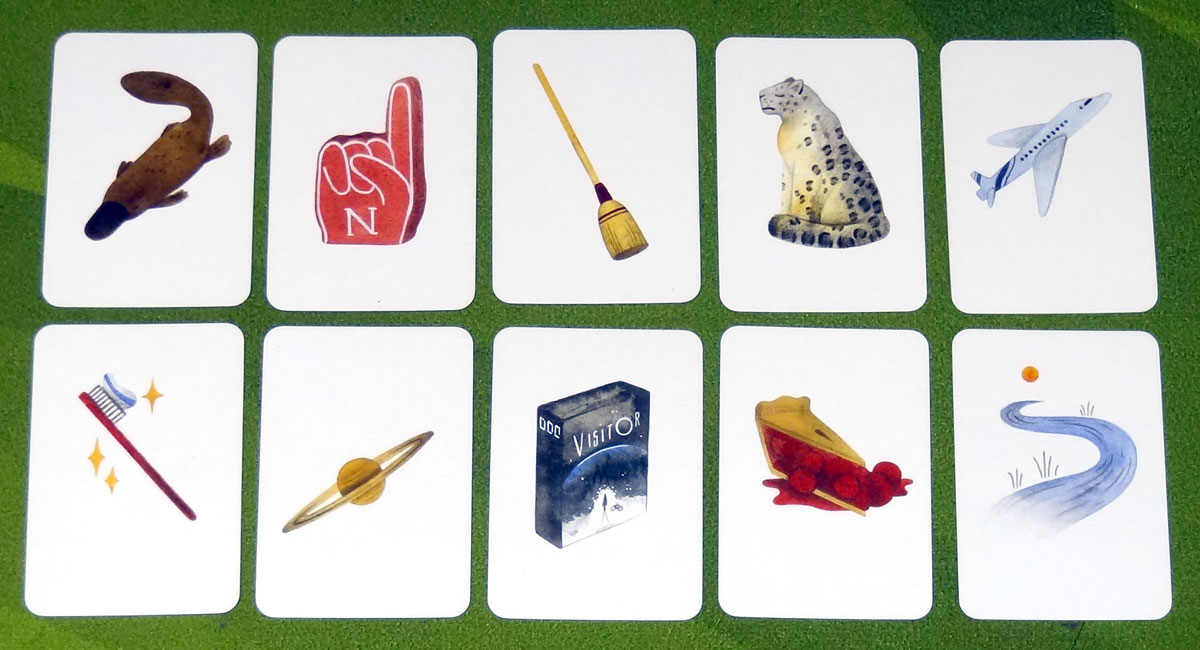
The object cards are small, Euro-style cards, each with an object of some sort illustrated on a plain white background. I really love the illustrations, which were done by Maggie Chiang—it’s a fun style and there are a host of different types of objects.
The pass rule cards give you some example rules that you can use, though once you’re familiar with the game you can come up with your own rules. Some of the examples are fill-in-the-blanks where you can change what’s underlined. The one strange thing about these cards is that they’re double-sided, with the same thing on both sides. So I always warn the visitor player, as they’re looking through the rules, not to hold the cards up because otherwise everyone can see what they’re looking at.
The little plastic clips aren’t entirely necessary, though each player can use them for marking their own cards in/out of the force field. They were a Kickstarter exclusive, but they’re fairly standard plastic stands, and it’s not a huge loss if you get the retail edition without them. The cloth bag is just used for storage of the pieces—it was a stretch goal, and is much nicer than a little plastic baggie, but otherwise serves the same purpose.
The whole thing fits into a fairly compact box, about the size of the Codenames box. If you wanted to travel with the game, you could probably make most of it fit in an even smaller package—the largest essential component is the trust mat, which doesn’t fold down. Oh, and one more fun feature: the cover glows in the dark!
How to Play Visitor in Blackwood Grove
You can download a copy of the rulebook here.
The Goal
The kid and all the agents each want to figure out the visitor’s pass rule; the visitor is on the kid’s team and wins if the kid wins.

Setup
Choose players to be the visitor and the kid; all other players are government agents. Players should sit so that the kid is directly to the visitor’s right. Give each player the corresponding marker tokens and role cards, and give the kid player the trust mat, with the meeple at the starting position. Deal each player 7 object cards.
Gameplay
The game begins with the agent directly to the visitor’s left, and proceeds clockwise. Each player type (agent, kid, visitor) has a different turn structure.
- Agents: Test or Prove, then draw a card
- Kid: Draw a card if you have none in hand, then Predict or Prove
- Visitor: Classify
Test: The agent chooses an object card from their hand and passes it secretly to the visitor. The visitor tells the agent whether the object passes the rule (and goes into the force field) or does not. The player markers are used to keep track of who cards belong to, because players are allowed to look at their own cards that have been tested.
Prove: The player (agent or kid) reveals the top four cards from the deck, placing them in a row. The visitor then arranges the guess tokens behind the shield, placing them either in the force field or out of it (corresponding to the order of the cards). The agent or kid then arranges the cards to show their guess, whether each card is in or out, and then the visitor reveals their answer (but does not explain the rule).
If the guess is correct, the player wins (and the visitor also wins if the kid successfully proves the rule). If an agent is incorrect, the kid gains 2 trust (along with the associated benefits). If the kid is wrong, nothing else happens.
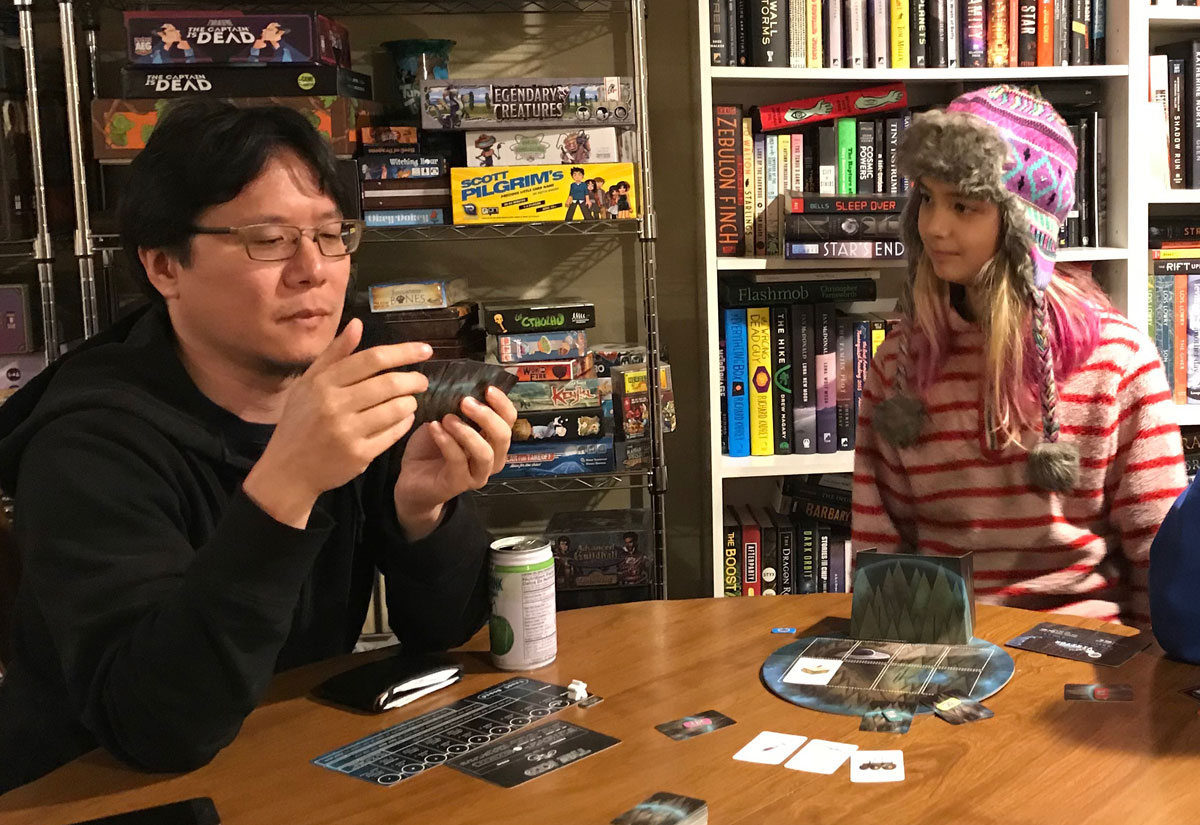
Predict: The kid may predict up to three cards, placing a card face up and guessing whether it passes or not. If they’re correct, they may continue, and will gain 1 trust for each correctly predicted card. If they’re incorrect, their turn ends and they don’t gain any trust at all, even if they got other cards correct this turn. For each trust gained, move the meeple one step on the trust mat, and then gain the benefits below. Note: the kid doesn’t draw cards automatically—only if they are able to gain trust.
Classify: The visitor’s turn is pretty simple: they choose a card from their hand, and classify it either inside the force field or outside. Note that there are 8 spaces inside and 8 spaces outside the force field for face-up cards, so if there are ever more than that, cards are covered up and may not be peeked at.
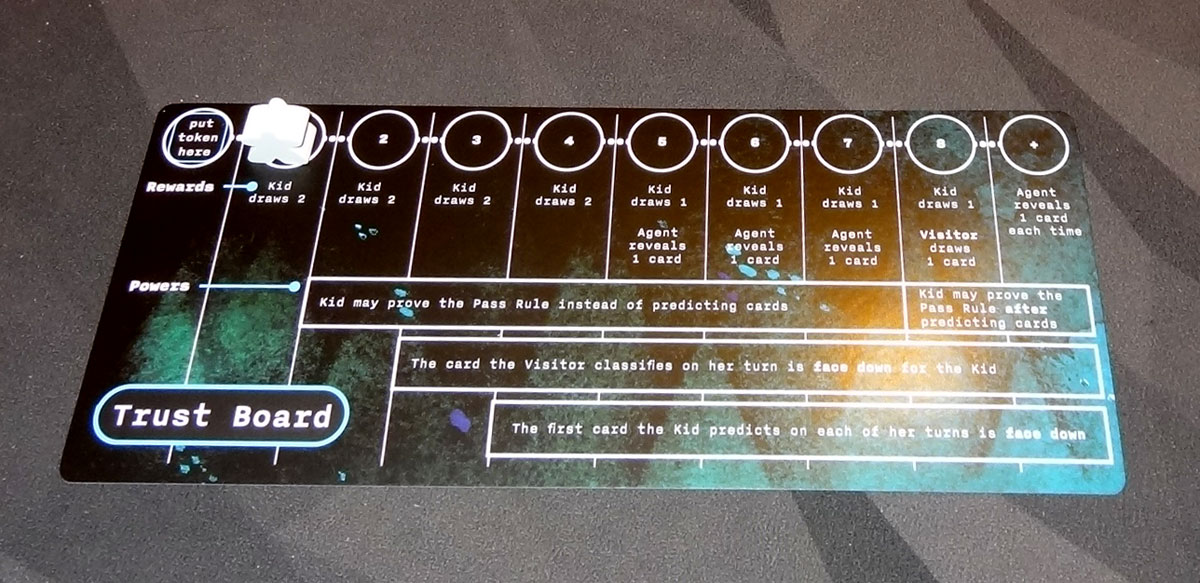
As the kid builds trust—either by correctly predicting cards or when the agents fail a prove attempt—the kid gets to draw more cards, but also unlocks more abilities both for the kid and the visitor. For instance, the kid isn’t allowed to attempt to prove the rule until at least trust level 2. After level 3, the card that the visitor classifies on their turn is placed face down and only the kid is allowed to look at it, and after level 4, the first card that the kid predicts is also face down.
At higher levels, it will force agents to reveal some of their face-down cards. The one note is that the only way for the visitor to draw a card is when the kid reaches trust level 8—otherwise the visitor only has the 7 cards they started with for the whole game.
Game End
If any player manages to prove the rule, that player wins. (The visitor wins with the kid.)
If the entire object deck runs out, the kid and the visitor win.
If the visitor has no cards at the beginning of their turn, the agents win as a group.
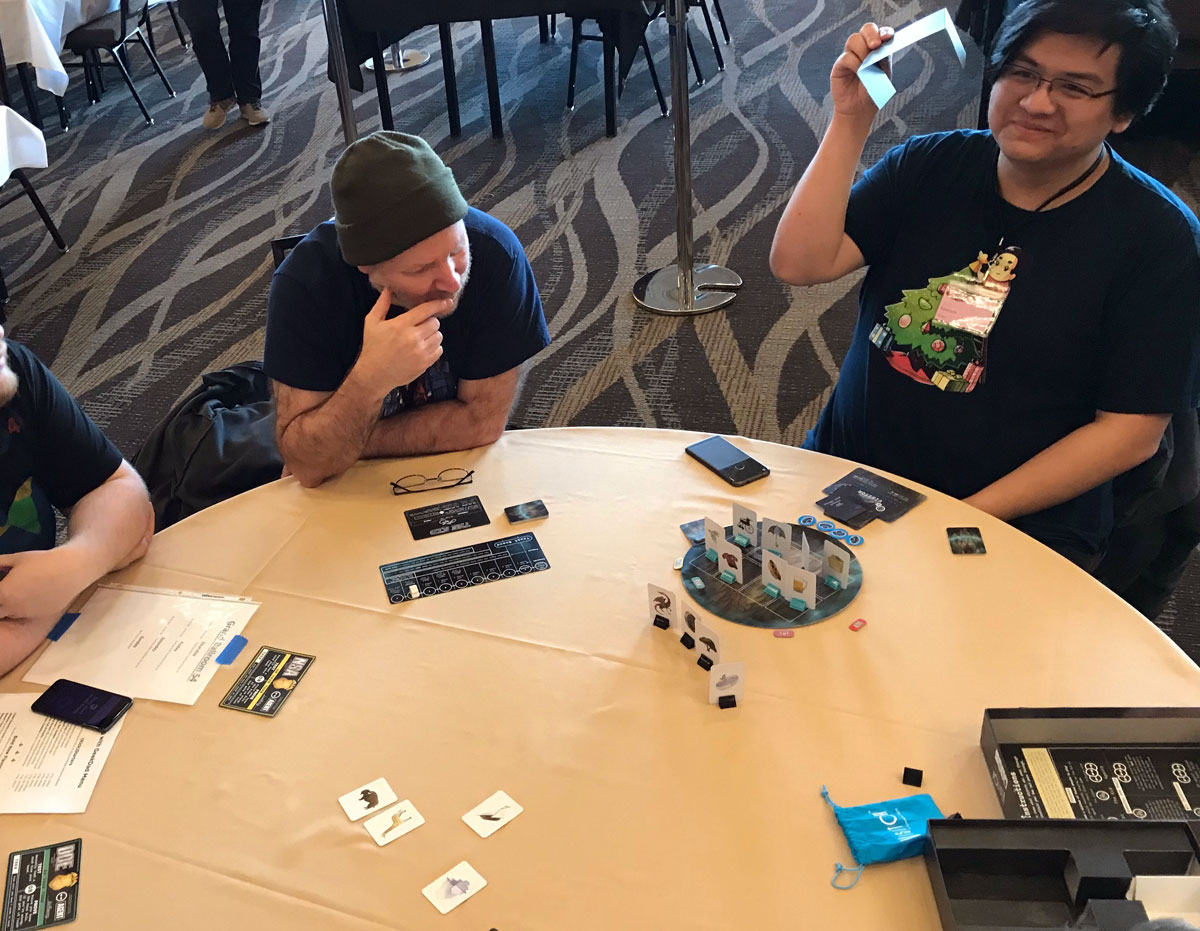
Why You Should Play Visitor in Blackwood Grove
I came across Visitor in Blackwood Grove when it was on Kickstarter, and was first struck by the evocative cover artwork. When I read a little more about it, though, I thought it would be a great fit with my other clue-based games like Codenames and Decrypto and Zendo. Like Zendo, it’s a bit of a puzzle-like game that requires inductive logic: you have to figure out what the common factor is in all of the objects that pass through the force field. But it also has an E.T.-like theme layered onto it, and while it’s not crucial to the gameplay, I think it adds a lot to the experience.
I particularly like the way that the kid has a different role than the agents. It’s a cool twist, because the visitor has a vested interest in helping the kid prove the rule, but until the kid builds up some trust, the visitor cannot give information privately to the kid—anything they classify is face-up. And until the kid builds up enough trust, all of their predicted cards are also face-up, which means they give more information to the government agents.
It also feels appropriate that the government agents are testing things secretly. You can just imagine each agency has its own little white canvas tent set up on the edge of the force field, pushing things at the barrier while people in labcoats write things down on a clipboard. And meanwhile, there’s this kid who just rode up on her bike, waved at the alien, and is just throwing things at the force field in plain sight. (My kids get particularly giggly about testing certain objects, like the pile of poo.)
The kid and the visitor only have a set amount of time, though, because the visitor uses one card per turn, and only starts with 7 (with a possibility of drawing one more). If they can’t win within 7 or 8 turns, the government agents finally work together and brute-force their way through. (At least, that’s the story I tell in my head.) So even with a really difficult pass rule, the game won’t go on forever.

Coming up with a good pass rule is important, and the rulebook gives a few suggestions about what types of rules are valid or recommended. For new players, the cards are handy, but since I’ve played more times, I’ve seen “things that contain red (or another color)” get picked many times by first-time visitor players, which makes it easier for me to guess. I think if you’ve got a consistent group, then you’ll be able to branch out into homemade pass rules, which will make for an even more interesting game.
It’s also interesting that, unlike Zendo, you don’t have to be able to articulate the rule: you just have to be right for the four cards you draw off the top of the deck. It’s possible to get lucky and be correct even though you were thinking of a different reason. But you don’t want to be too hasty in making a guess if you’re the agent, because it may give the kid trust, which helps the kid and the visitor, and also because it may run out the object deck.
There are also times when things get a little tricky and the visitor has to make a judgment call: is a blanket a “thing with strings”? Does an animal “contain metal” because it has iron in its blood? Of course, if you make a weird ruling as the visitor, you should be prepared to defend your answer—probably, this game will be more enjoyable if your visitor isn’t somebody who says “technically” a lot.
I really love these sorts of games that involve some logical reasoning and figuring out clues, so I’m really glad I backed Visitor in Blackwood Grove. I’ve taught it to a variety of different players, and the majority have really enjoyed it, often playing multiple times so that players can get a chance to try out the different roles. If you’re a fan of games like Codenames or Zendo (and particularly if you like E.T.), you may really enjoy this one as well!
Look for Visitor in Blackwood Grove at Target!
Click here to see all our tabletop game reviews.
If you’d like to stay up-to-date with all of our tabletop gaming coverage, please copy this link and add it to your RSS reader.
